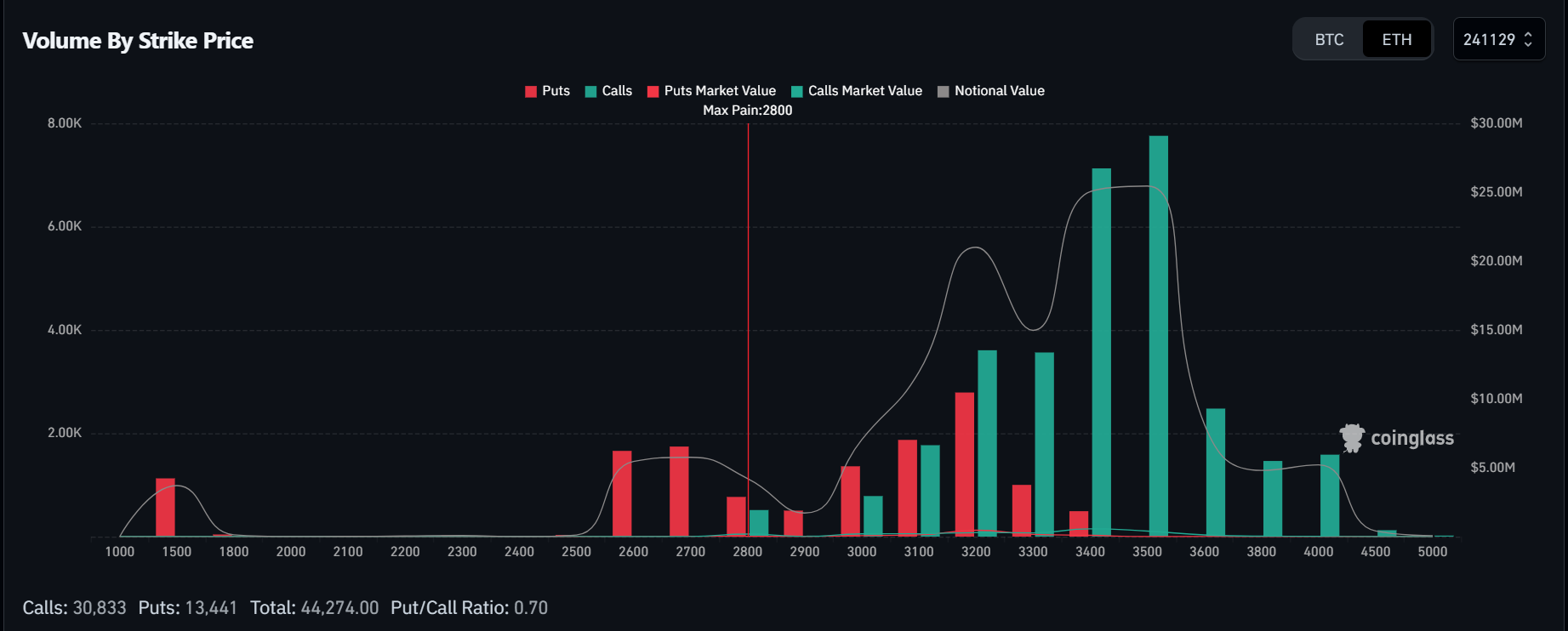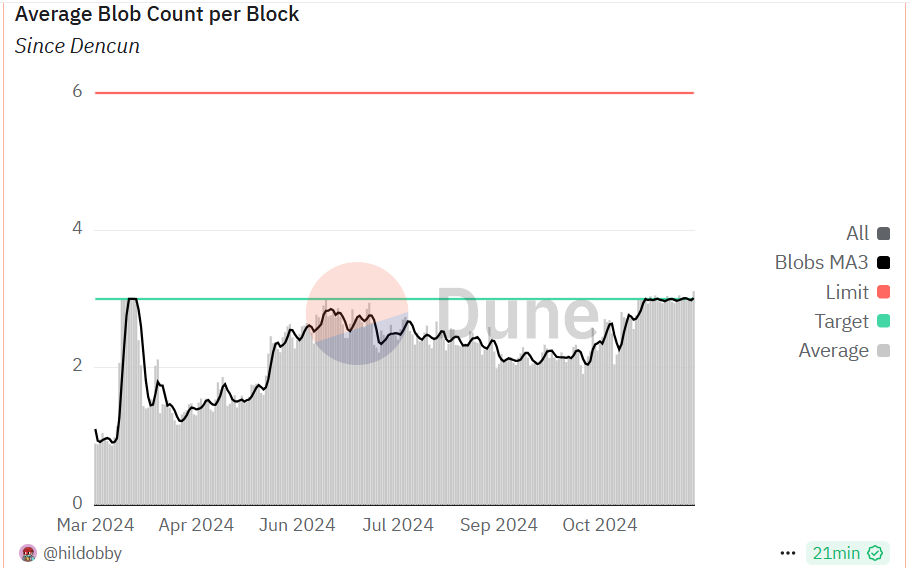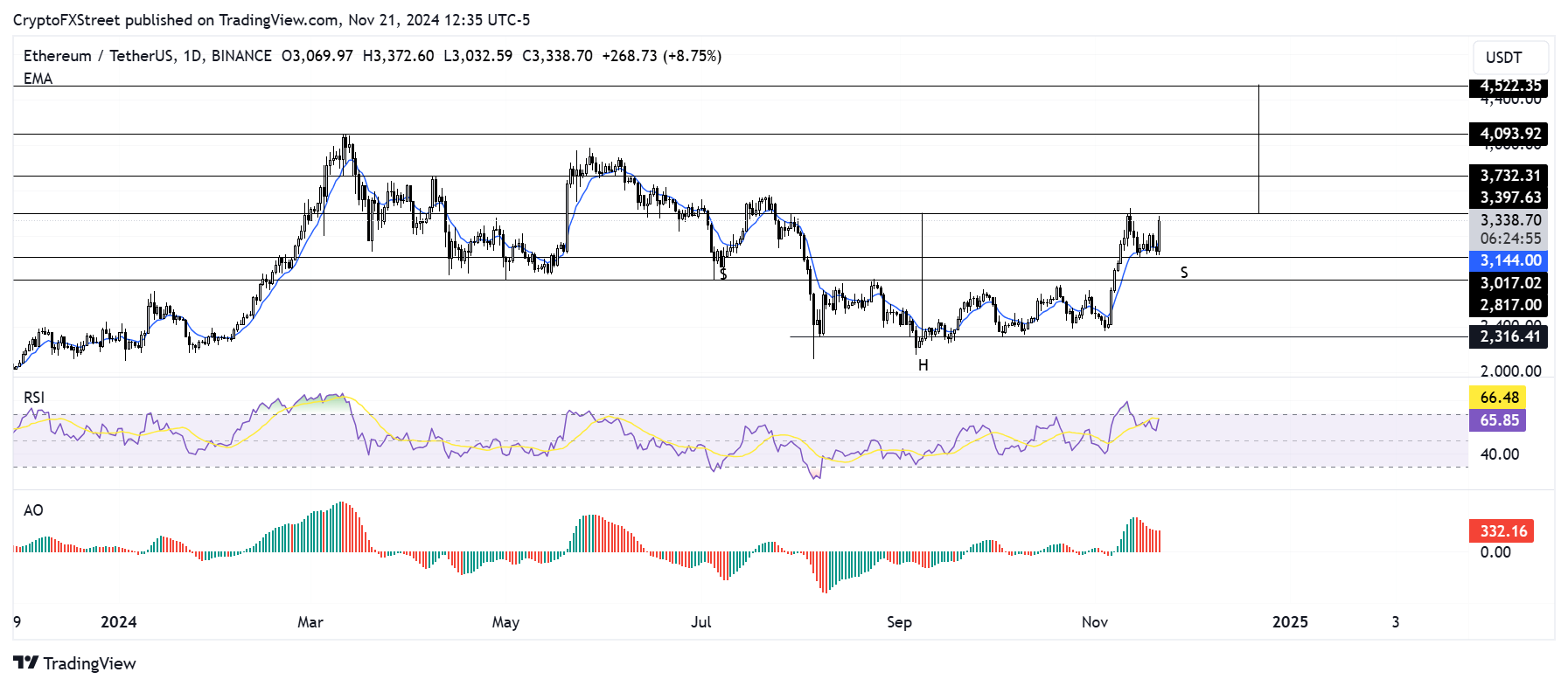Ethereum Price Forecast: ETH open interest surge to all-time high after recent price rally
Ethereum price today: $3,350
- Ethereum derivative traders have flipped bullish as ETH's open interest crossed the $20 billion mark.
- Ethereum blob space per block exceeded its limit of 3, indicating a potential price increase.
- Institutional investors may have flipped bearish on ETH after five consecutive trading days of net outflows.
- Ethereum's quest for a 30% rally gained strength after it broke out of a week-long consolidation with an 10% rise.
Ethereum (ETH) is trading near $3,350, experiencing an 10% increase on Thursday. This price surge is attributed to strong bullish sentiment among derivatives traders, driving its open interest above $20 billion for the first time. Additionally, the average blob space per block has exceeded its limit level of 3, indicating that ETH's supply may become deflationary once more.
Ethereum open interest surge and blobs increase indicate rising bullish pressure
Ethereum's futures open interest surged over 11% to an all-time high of $20.27 billion on Thursday following its recent 10% price rise. Open interest (OI) is the total number of outstanding contracts in a derivatives market.

ETH Open Interest | Coinglass
ETH's increased OI indicates that investor confidence in the top altcoin is rising again following a week-long consolidation.
A similar bullish sentiment is also visible among ETH options traders on the Deribit exchange.
The ETH options volume by strike price for the November 29 expiry is concentrated on the $3,400 and $3,500 levels, with calls significantly dominating puts. This indicates that most options traders expect ETH to cross the $3,400 and $3,500 price levels before the end of November.

ETH Options Volume by Strike Price | Coinglass (Deribit)
Additionally, Ethereum's average blob count per block recently crossed the limit level of 3, indicating Layer 2 networks are posting higher transactions to the Main chain, per @hildobby Dune dashboard.
When the average blob count per block exceeds 3, it triggers higher transaction fees for Ethereum. If the trend continues, it could accelerate ETH's burn mechanism, leading to a decline in its total supply and a potential price increase.

ETH Average Blob Count per Block | Dune
However, institutional investors maintain a bearish outlook as Ethereum exchange-traded funds (ETFs) posted net outflows of $30.3 million on Wednesday, per Coinglass data. This has stretched their negative flows streak to five consecutive trading days of outflows, totaling $213.7 million.
Ethereum Price Forecast: ETH resumes quest for $4,522 after one week of consolidation
Following its 10% rally, Ethereum futures traders saw $86.45 million in liquidations in the past 24 hours. Liquidated long and short positions accounted for $37.13 million and $49.33 million, respectively.
As a result, ETH is testing the $3,397 neckline resistance of an inverted Head-and-Shoulders pattern after bouncing off the 14-day Exponential Moving Average support line. If ETH sustains a firm close above this resistance, it could rally over 30% to $4,522. However, it has to overcome key resistance levels at $3,732 and $4,093 to complete such a move.

ETH/USDT daily chart
The recent rise comes after ETH consolidated near the $3,000 psychological level in the past seven days to validate the shoulder support of the inverted Head-and-Shoulders pattern.
The Relative Strength Index (RSI) momentum indicator is trending upward above the neutral level, indicating dominant bullish pressure.
The Awesome Oscillator (AO) is posting consecutive red bars above the neutral level, indicating the bullish pressure isn't strong.
A daily candlestick close below $2,817 will invalidate the bullish thesis and send ETH toward $2,250.
Ethereum FAQs
Ethereum is a decentralized open-source blockchain with smart contracts functionality. Its native currency Ether (ETH), is the second-largest cryptocurrency and number one altcoin by market capitalization. The Ethereum network is tailored for building crypto solutions like decentralized finance (DeFi), GameFi, non-fungible tokens (NFTs), decentralized autonomous organizations (DAOs), etc.
Ethereum is a public decentralized blockchain technology, where developers can build and deploy applications that function without the need for a central authority. To make this easier, the network leverages the Solidity programming language and Ethereum virtual machine which helps developers create and launch applications with smart contract functionality.
Smart contracts are publicly verifiable codes that automates agreements between two or more parties. Basically, these codes self-execute encoded actions when predetermined conditions are met.
Staking is a process of earning yield on your idle crypto assets by locking them in a crypto protocol for a specified duration as a means of contributing to its security. Ethereum transitioned from a Proof-of-Work (PoW) to a Proof-of-Stake (PoS) consensus mechanism on September 15, 2022, in an event christened “The Merge.” The Merge was a key part of Ethereum's roadmap to achieve high-level scalability, decentralization and security while remaining sustainable. Unlike PoW, which requires the use of expensive hardware, PoS reduces the barrier of entry for validators by leveraging the use of crypto tokens as the core foundation of its consensus process.
Gas is the unit for measuring transaction fees that users pay for conducting transactions on Ethereum. During periods of network congestion, gas can be extremely high, causing validators to prioritize transactions based on their fees.

